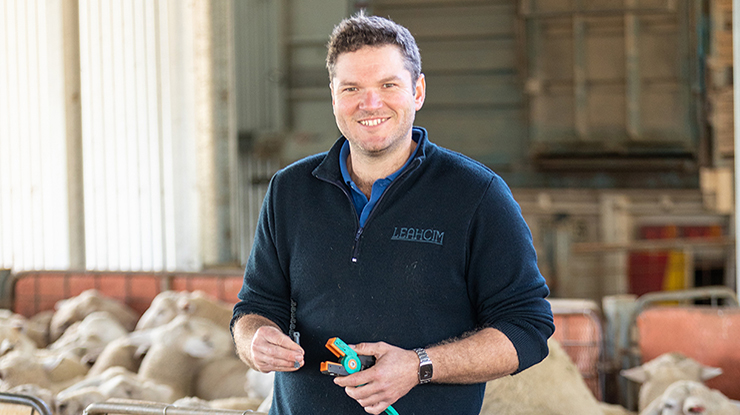 Sheep producer Alistair Michael, has found individual tagging has improved efficiencies at ‘Leahcim’.
Sheep producer Alistair Michael, has found individual tagging has improved efficiencies at ‘Leahcim’.
Efficiency and accuracy ride on back of sheep eID
Key points
- Use of eID has helped to speed up decision making.
- Data collected helps to maximise breeding and selection decisions.
- The use of eID makes it easier to analyse performance over the long term and measure improvements in breeding values.
Individual electronic identification (eID) tags for sheep and goats are set to become mandatory across Australia by the start of 2025.
Here, SA sheep producer Alistair Michael of ‘Leahcim’ explains how individual tagging has improved efficiencies in his family’s business and helped them extract more value from the data they collect.
The Michael family started farming around SA’s Barunga Range area in the late 1800s, but it took another century before the enterprise diversified its holdings and began to focus more on sheep and wool production rather than cropping.
The enterprise started performance recording Merinos more than 35 years ago and became early adopters of sheep eID in 2011. Today, Leahcim has one of the most measured sheep flocks in the world – something that’s increasingly essential to the success of their genetics business.
“We came on board before sheep tags were available, so we actually started out using cattle tags during that first year,” Alistair said. “We were just so keen to start streamlining the recording of our production traits and speed up our decision making.”
Real-time breeding values
These days, all Leahcim sheep begin their eID journey when a Shearwell ear tag is placed during lamb marking. A DNA sample is taken at the same time and linked to the lamb’s eID, together with a record of their parentage and genomic information.
Using the data from that DNA sample, Alistair can map the sheep’s genes to maximise his breeding and selection decisions.
“When we’re in the yards we simply scan the e-tag and the animal’s breeding values come up in real time. That’s helping us make breeding decisions much more efficiently than when we had to trawl through paper records.”
Efficient, accurate record-keeping
Alistair said that when compared to the old paper-based system, the eID had delivered impressive improvements in both time saved and errors eliminated.
“The eID’s real-time recording of data is probably saving us two months of labour every year,” he said. “A lot of that time would have been punching in numbers at 11 or 12 o’clock at night when you’re most likely to make a mistake.”
With the business running 8,000-10,000 sheep, Alistair estimates they collect about 30,000 to 40,000 individual data points each year.
“We’re dealing with a huge volume of data and the eIDs have also helped us eliminate the 10–15% of recording errors we were getting when we had to do it all by hand.”
Improved use of resources
After joining, the ewes are pregnancy tested and grouped according to foetal age.
“We run them through the auto drafter and eID lets us separate them into groups based on two-week lambing windows,” Alistair said.
“That means we can keep the ewes on the paddock right up to the last minute and be certain they’ll then lamb within two weeks, instead of potentially having to race around the paddock with trail feed at the point of lambing.”
This individual management is helping the business manage its available feed more efficiently, as well as helping preserve the paddocks and reduce erosion because the ewes won’t be on paddock any longer than necessary.
Meaningful insight and analysis
Alistair said the eIDs haven’t just made it easier to capture the data, they’ve also made it easier to analyse performance over the long term and measure improvements in breeding values.
“Because we’ve got the electronic records, it takes me five minutes to go back and look at things like post-weaning weights, for example,” he said. “I can see that since we started tracking our performance 35 years ago, our post-weaning weights have lifted by 20kg, which is huge.
“I can also see we’ve lifted our eye muscle depth from 26mm to 32mm – that’s increased the yield on those carcases by 6–8%.
“The data is providing enormously valuable insights into our performance over time and the success of our genetics program,” Alistair said. “However, if I had to muck about sorting through paper f iles to get it, I’m not sure I’d actually have the time or inclination to do it.”
Building a premium wool brand
This year, the Michaels have diversified further and created Leahcim Wool, a new business selling and promoting their wool products using their best fleeces.
Using hip wool testing, each sheep’s micron, CVH and comfort factor are recorded against their eID and downloaded into a file.
“We use this data to identify the sheep with best testing wools for our Leahcim Wool business and use the eID to separate them out with the auto drafter. It’s how we ensure we’re marketing our wool according to its quality and that we’re making a premium on that fine end.”
Supporting a quality-based payment system
In May, Leahcim ran a first-of-its-kind abattoir trial to establish the match between lamb genomics and eating quality.
The trial was designed to look at shear force, intramuscular fat and lean meat yield on about 100 White Suffolk and 300 Merino yearling lambs with full genetic profiles recorded against their eIDs.
“Leahcim was heavily involved in the Sheep CRC Information Nucleus Flock when it was in use and, in recent years, we’ve invested heavily in sheep genomic 50k sequencing,” Alistair said. “We are looking to validate that investment over time in hard to measure eating quality traits.”



